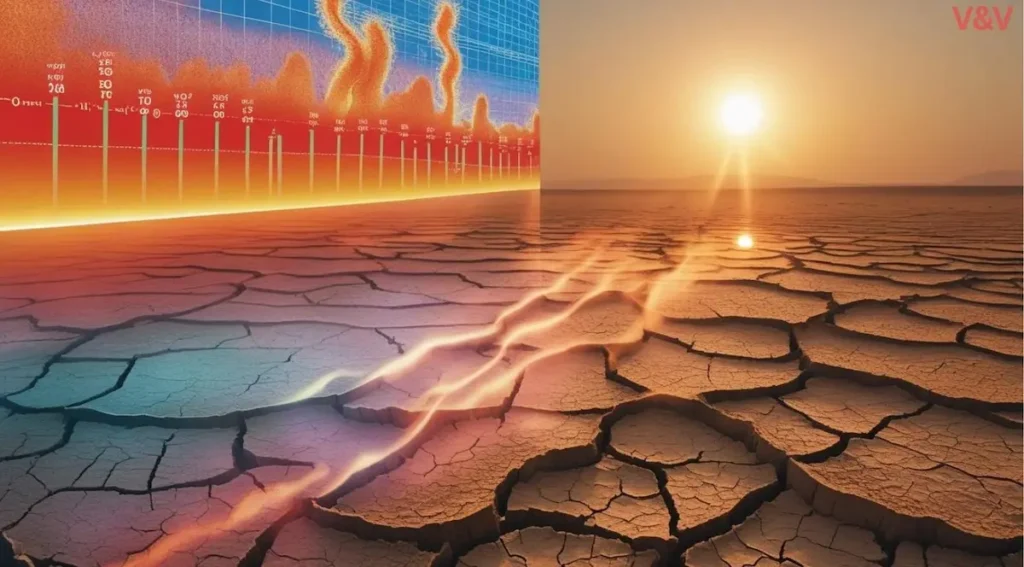In the latter part of the year, the capital city witnesses the water sprinklers to tackle the problem of pollution. It looks like, the water sprinkler solution is going to be a permanent one, except this time, to tackle India’s heatwave crisis. Journals are lined up with the same headlines as every year about warm summers and heat crises. Clearly, government policies to address this crisis are as futile as the government’s intent to actually make a difference.
As heatwaves grip large swathes, causing deaths, displacing the poor, and crippling outdoor labour, the official playbook remains largely unchanged. Generic advisories, lukewarm policy briefs, and an astonishing reliance on citizens to “stay indoors”, a luxury not everyone can afford.
Let’s understand how and why India’s heatwave crisis might just be the ‘tipping point’ that scientists have been warning about for a long while now.
Burning Days, Blistering Data: India’s Heatwave Chronicles
According to the ‘National Centre for Disease Control‘ and ‘Heat- Health Preparedness Report’ 48,156 suspected heatstroke cases have been registered, along with 269 suspected and 161 confirmed heatstroke deaths in 2024.
In addition to this, 2024 was considered one of the warmest years on record and the first year above 1.5°C from the pre-industrial levels. The previous year’s statistics are enough to predict the condition of heightened heatwaves in India this year.
“April 8th 2025, approximately thirty weather stations spread throughout India documented temperatures exceeding 43.0 degrees C (109.4 degrees F) with many areas classified as experiencing severe heatwave conditions according to official meteorological conditions.” The severity of the heatwave crisis has been hitting hard for the past half a decade. Maximum temperatures are reaching up to 49 Degrees C that too, in May.
What’s worse, these heatwaves are no longer freak events. They’re becoming longer, deadlier, and frequent, a clear sign that climate change isn’t knocking politely but breaking down the door. Yet, national discourse largely treats it as just another seasonal inconvenience. According to the India tracker, “On May 19, Delhi experienced a sweltering day. While the temperature touched 40.8°C—usual for this season—the 44% humidity pushed the heat index to 48.5°C.”
Climate scientists have linked India’s heatwave crisis to anthropogenic climate change. A report by the Intergovernmental Panel on Climate Change (IPCC) warns that South Asia is among the regions most vulnerable to heat-related extremes. India is projected to face an eightfold increase in deadly heatwaves by 2050 if global emissions aren’t curbed.
Health Consequences Of India’s Heatwave Crisis
World Health Organisation defined heatwaves, when “the maximum temperature of a station reaches at least 40°C or more for Plains and at least 30°C or more for Hilly regions.”
The heatwave crisis in India again proved that it’s the poor who bear the heaviest burden in times of adversity. In such situations government advisories such as ‘staying indoors’ don’t work because it is a luxury to work at home. There are multiple and serious health impacts of the prolonged heatwave.
The health-related effects are largely in the form of heat strokes, dehydration, organ failure (gastrointestinal damage, kidneys) and cardiac arrests. In extreme cases, these conditions can lead to mortality. The greatest impact of India’s heatwave crisis is the decline in productivity due to heat cramps, exhaustion, heatstroke and hypothermia. In densely populated urban slums, where ventilation is poor and water access is unreliable, the heat becomes slow, suffocating threat.
Gaps to Fulfil to Cope With India’s Heatwave Crisis
Immediate and urgent need for better healthcare policies along with aggressive implementation is required to deal with a surge in heatwave cases. India’s current heat action plan is for 23 states vulnerable to heat and a national action plan on heat-related illnesses.
Although, on paper, the heat action plan covers measures such as early warning systems, public awareness, cooling centres, water availability, and hospital preparedness, however, the ground reality is very different. “Inadequate infrastructure, lack of trained personnel, insufficient heat action plans and policy coordination” are some more additions to heatwave crisis.
The problem of India’s heatwave crisis has reached a pinnacle. There are no effective solutions that can solve this glaring inefficiency. Most of the measures are focused on mitigating short-term crisis management instead of long-term and thus, the vulnerable population suffers. Even if long-term resilient measures exist in a few states, the implementation is particularly weak. While HAP claims to disseminate information at the earliest, there is a lack of proper knowledge regarding the heatwave crisis. The HAPs even fail to acknowledge the social and economic factors that exacerbate heatwave-related health issues. Problems like inadequate housing, lack of access to clean water and precarious outdoor employment are fueling the already mounting heatwaves. Despite being issued, heatwave alerts in India frequently fall short, either misrepresenting on-ground conditions or failing to reach those at greatest risk. Public outreach and awareness campaigns are often just pseudo attempts at working.
Socio-Economic Factors: Is Heatwave a Natural Disaster In India?
The Dystopian fiction that we have been reading in books might soon become a reality if India’s heatwave crisis is not dealt with, in time. Heatwave, if it still has not, would become a natural disaster affecting agriculture and labour the most. In agriculture, extreme heat disrupts crop cycles, damages yield, and dries up water sources. Studies by the Indian Council of Agricultural Research (ICAR) show that rice and wheat yields can drop by 10–20% with just a 1°C rise in temperature. In states like Punjab and UP, farmers are being forced to harvest earlier or switch to heat-resistant low profitable crops. Add erratic monsoons to the mix, and farming becomes an increasingly unstable gamble.
Meanwhile, manual labourers, from construction workers to street vendors, face the brutal paradox of working more during summer months. Thus, they also have to face the highest health risks. Without paid sick leave or government-mandated heat breaks, they are forced to choose between heatstroke and hunger.
Densely populated country as India also has to be equipped with dealing large number of vulnerable populations in such situations. Certain groups, such as the elderly, those with pre-existing health conditions, and outdoor workers are disproportionately affected by heat waves. Rural populations, low-income communities, and marginalized groups often face limited access to healthcare and preventive measures, further exacerbating their vulnerability.
Call To Action
Despite India being a part of multiple International conferences like UNFCCC and being an active member of various agreements such as the Paris Agreement and Global Framework for Climate Services, the result has been underwhelming.
What our country currently needs is an enthusiastic measure along with its implementation to control this silent disaster. Structural reforms are urgent need, such as aggressive collection of data, cooling zones, heat-prone food crops to sustain the growing heat, better infrastructure development and proper utility of AI to tackle the problem of India heatwave alert. The health sector also needs an update to accommodate the climate and heat waves. What’s more is perhaps most critically, there must be a shift in public consciousness because heatwaves cannot remain invisible disasters.
This climate emergency must be dealt with before we are too late, if we aren’t already because silence is unaffordable and delay is deadly.
Also read: Waqf Amendment 2025 in Supreme Court



Pingback: Desk Yoga for Anxious Office Workers: 7 Moves for Calming Nerves - V&V